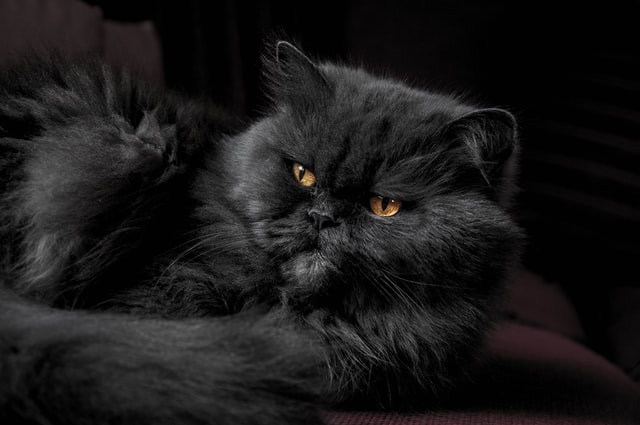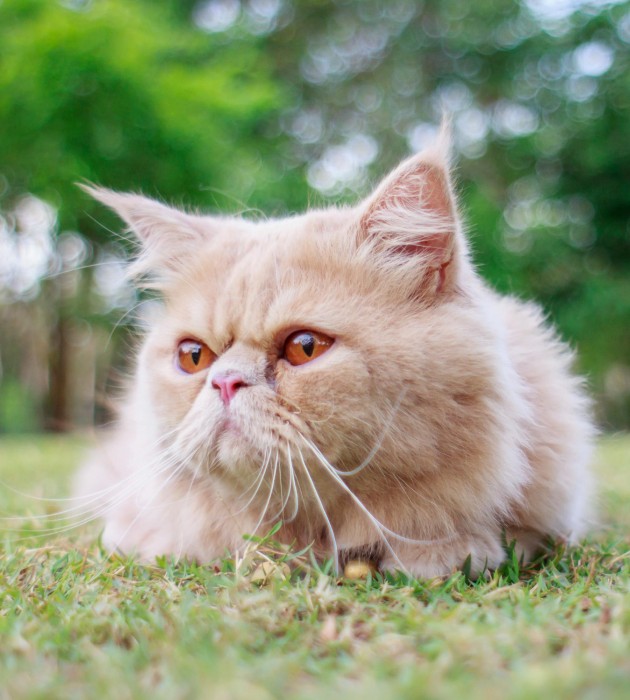
Persian
Posted: 09/02/2024 | BY: Content Writer
Persian Cat Breed Profile
Pet profile
Perfect for owners looking for cat who is both affectionate and intelligent
- Medium (25cm to 40cm)
- Typically weighing between 3kg and 5kg
- 10 to 25 years life expectancy
The royalty of cats, the Persian is an exotic breed that has been a family favorite worldwide for hundreds of years.
Affectionate and laid back, the Persian is perfect for quiet homes and owners looking for a prince or princess to pamper.
The Persian is a popular cat breed that loves to be spoilt. They love affection, treats, and relaxing all day slumped across a chair. However, they can be picky about their friends, preferring only to give attention to family members and certain trusted guests.
Due to their relaxed nature, they prefer a quiet household without too much hustle and bustle, so a home with young children is not always suitable for a Persian.

History of Persian Cats
The origin of the Persian is uncertain. The first documented mention of these cats is from Italy in 1620, but some references to similar-sounding cats have been found in hieroglyphics.
They first came to America in the early 1900s, after making quite a splash in Britain and becoming a favorite of the British Queen, Victoria.
Characteristics of Persian Cats
The Persian cat is recognized by its short nose, large eyes, and long, luxurious coat, which requires daily grooming. The Persian cat’s fur is very soft. Recognized colors are solid colors, blue, reds, browns, cream, tabby, cameo, silver, and gold Persians.
The longhaired cats are known for their sweet personality. Persian cat owners love their chubby cheeks and say they make the best feline friend. They do well with one owner in quiet homes and are not generally great with children though.
Because it is a brachycephalic (flat-faced) breed, the Persian is unfortunately predisposed to certain related health conditions such as breathing difficulties and eye problems.
Persian cats are easy to train to use a litter box and make great house pets. These affectionate cats can even get along with other household animals with proper introductions.
Adopting A Persian Cat From A Breeder Or Rescue
It is recommended that you adopt Persian cats from reputable Persian breeders recognized by the Cat Fanciers Association to avoid health issues.
Persian cats can also be adopted from Persian cat rescues and sometimes even shelters.
Exercise And Nutrition of Persians
Persians do not have a high energy level and are happy to live as indoor cats. They spend most of their days lounging around the house but do enjoy chasing a feather cat toy or playing a game of fetch with their owners.
Independent in nature, they can generally entertain themselves in the house for a few hours happily, so can be left alone for periods of time.
The Persian is pretty smart and will know exactly when it’s mealtime (and will let you know too!). It’s therefore important to keep to a regular feeding schedule so as not to cause stress or anxiety in your cat.
Persians should be fed a high-quality diet that is suitable for their age. They are not fussy eaters, but will soon learn (or rather, teach their owners) that if they leave their food untouched they will be brought something better, so try not to treat your cat if they are not eating straight away.
Common Health Problems And Illnesses Of Persian Cats
Due to the fact that they are flat-faced, the Persians is prone to a variety of illnesses and conditions. It’s therefore important to insure your Persian kitten as soon as possible to ensure that any conditions that develop will be covered by your cat insurance policy.
The flat faces of Persian cats can cause a variety of eye problems:
Epiphora
This is when the cat’s eyes water excessively, and their tears aren’t drained properly. This happens when a duct that drains tears from the eyes is blocked or doesn’t function properly.
If you notice redness or infection around your cats’ eyes, take them to the vet as the wet surface can be a breeding ground for bacteria and the infection will need treating.
Entropion
This condition is where the eyelids and eyelashes turn inward instead of outward. This means the eyelashes scratch the surface of the eye and this irritation leads to excess tearing, inflammation of the eye, and eventually bacterial infections.
The continual contact between the lashes and the eye can lead to permanent damage to the cornea.
Progressive Retinal Atrophy (PRA)
Progressive retinal atrophy is the term used to describe a group of genetic disorders that results in degeneration of the retina. This can lead to a gradual and progressive decline in eyesight and in some extreme cases can lead to blindness.
A variety of breeds can be affected by this disease. In Persian cats specifically, an autosomal recessive form can affect their eyesight, with clinical signs being identified as early as 2-3 weeks of age and almost complete retinal degeneration by 4 months of age.
The cause behind the genetic mutation that causes this form of PRA has not yet been identified. Owners should watch out for signs that their cat is disorientated or bumping into objects; this could indicate that their vision is deteriorating.
Polycystic Kidney Disease is a life-threatening condition where cysts form on the kidney. These can cause organ failure and unfortunately cannot be removed. Your vet can usually offer medication to minimize the symptoms and delay kidney failure.
Your breeder should have had both parents’ DNA tested for the disease, but even if it is not detected there could still be a chance of your cat becoming ill.
Due to their flat faces which restrict the nostrils, Persians can, unfortunately, suffer breathing difficulties. These can range from snoring and snorting to more serious difficulties which may require corrective surgery.
It is important to keep an eye on your Persian’s breathing and visit your veterinarian if they seem to be struggling.
The restricted breathing also means that Persians are prone to overheating so make sure that all playtime is gentle and doesn’t go on for too long. Similarly, it is a good idea to keep Persians indoors in case they overdo it outside and start overheating.
Mats can form in the Persian cat’s long hair if they are left to their own devices. If the cat grooms over-matts or foreign objects in their fur they can make the situation worse and cause further knots.
Whether mats that form are large or small, they can cause irritation and a lot of pain as they will pull at the skin. Cats will often try and fix the mat themselves, which can lead to excessive hairballs and as a result, can cause blockages in the intestines.
To prevent your Persian from developing matted fur brush them daily and watch out for mats forming behind the ears, the backs of their legs, under their front legs, and around the collar and groin areas.
For small to medium mats, you can try to brush them out yourself or pick them apart to make them easier to tackle. Whereas, for medium to large mats your cat will need to go to a groomer or vet to be treated.
Don’t try to cut the mat out yourself, cats have very thin skin, and this can be dangerous.
Yeast infections
These infections can occur in cats with low immune systems and can start in the genital region, ear canals, or anus. It’s important to catch these early as they do tend to spread. They are usually treated with creams and can take a while to cure.
Parasites
All breeds can be affected by parasites such as fleas, lice, mites and ticks. Persians are more sensitive to contracting a flea allergy, which occurs when the cat is allergic to the saliva of fleas.
This can affect the cat as it is very irritating, and the scratching can cause sores. Treat to prevent flea and ticks and take your Persian to the vet if you notice they are in any discomfort.
Fungal infections
These types of infections tend to affect the Persians more than most breeds. Fungal infections can cause dry patches of skin and hair loss. If left untreated discoloration or rough patches on the skin caused by the fungal infection can develop into lesions.
Indoor cats are more likely to become obese because of lack of exercise and more time spent around snack-dispensing humans. Obesity can lead to a range of health concerns and should be addressed as early as possible. See our page Cat Obesity for more information.
Fun Facts About Persians
- The Persian rose to popularity in Britain partly due to Queen Victoria’s love for the unique breed
- The Persian featured in the world’s first-ever cat show in London in 1871, which drew in over 20,000 visitors!
- There is a species of Pokémon named after the Persian cat, although it resembles more of a cougar.
- Persians are nicknamed “furniture with fur” due to their love of lazing around
- The 1970 Disney movie, The Aristocats, featured a white Persian named Duchess.
